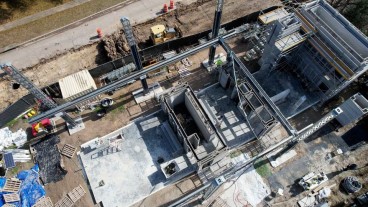Backyard homes to be built by 3D printers

Ross Maguire, CEO of Azure Printed Homes, is holding what looks like a piece of white plastic but he says it’s the future of accessory dwelling units, or more commonly known as ADUs, that clients can customize.
“They can add and take away as much glass or solid wall as they choose,” he said. “They can add windows, doors where they choose.”
The model represents ADUs that Maguire and his team designed and customers can choose the colors, finishes and other details on the unit with the few clicks of a button. Afterward, the entire backyard home is created with a 3D printer.
Maguire has over a decade of construction experience in the United Kingdom and launched the company in 2019 with co-founder Gene Eidelman after becoming frustrated with traditional build methods, which he says can take months and harm the environment with its sizable carbon emissions footprint.
“We could see if we printed something that would allow us to do it in a factory, then we could create more of the structure rather than just the exterior walls, so making the whole process more efficient,” he said.
Sustainability is a priority so he says they use recycled plastic and fiberglass to build the homes.
Maguire said his company can 3D print an ADU in one day and ship it to a customer in five days. They’re gearing up to print 180 square-foot studio units, which cost $40,000 and there is a three-month waitlist as they have $4 million in preorders. They also plan to print larger ADUs, up to 1,200 square feet with two bedrooms.
Cost and time are the two main challenges when it comes to building ADUs, but Dana Cuff, director of cityLAB at UCLA, said each unit can go a long way toward meeting housing goals.
“There are 500,000 single-family properties in Los Angeles alone. Let’s just say 10 of those build a legal ADU, we would have 50,000 new units of housing,” she said.
Cuff co-authored California state legislation in 2016 that makes it easier to build ADUs and said 3D printing is very promising.
“It can be more cost efficient and especially more efficient in terms of time and the whole destabilizing aspect of construction,” she said. “You still have to build a foundation and do all the same infrastructure work that you would for another unit.”
Maguire estimates less than 1% of people have ever seen a 3D printed home but he’s hoping to change that, first with ADUs and then larger houses.
“I see in like five years, ten years' time, that number being more like 20% and that number growing,” he said.
Source: spectrumnews1.com
Want to read more like this story?

The first 3-D-printed, two-story home is under construction in U.S.
Jan, 12, 2023 | NewsA 3D printer is taking home building to a new level. The enormous printer weighing more than 12 ton...

Melbourne: the first 3D-printed house in southern hemisphere
Jan, 18, 2022 | NewsThe first ever 3D-printed house in the southern hemisphere has been built in a Melbourne manufactur...

The world’s most exceptional 3D printed homes
Apr, 10, 2024 | News3D printing technology is a revolution at the construction sector, enabling builders to fabricate h...

Printout homes using new techniques: the rise of 3D-printed houses
Aug, 18, 2021 | NewsPalari Homes and Mighty Buildings company is using a new technique to build houses within 24 hours....

Texas: The World’s Largest 3D-Printed Community Is Coming
Nov, 10, 2021 | NewsThe 3D-printing method has become an alternative to building houses based on the old-fashioned way,...

Australia: plans for the construction of the first 3D-printed social housing units
Aug, 23, 2024 | NewsIt is widely known how revolutionary is the technology of 3D-printing. More and more 3D-printed pro...

Dubai plans to build the world's first 3D-printed mosque
May, 03, 2023 | NewsDubai aspires to build the world's first 3D-printed mosque, that will cover an area of 2,000 square...

Ohio’s first 3D-printed building is about to be constructed in Linden
Sep, 16, 2024 | NewsThe first 3D-printed building is about to be constructed on 26th Avenue in Linden, Columbus, Ohio b...

1st 3D Printed Office Building
Jul, 01, 2015 | NewsThe United Arab Emirates announced that it will proceed with the creation of the first building to b...
Trending

Spectacular interchanges around the world

STAAD.Pro 2024 New Release

New Release - STAAD.Pro 2025

New Release - STAAD.Pro 2024 - 2

ADINA 2025 for Structural WorkSuite

Bridge collapse in Bihar’s Araria: Probe ordered for the structural failure

Suspension bridge collapses in seconds during flood in central Vietnam

